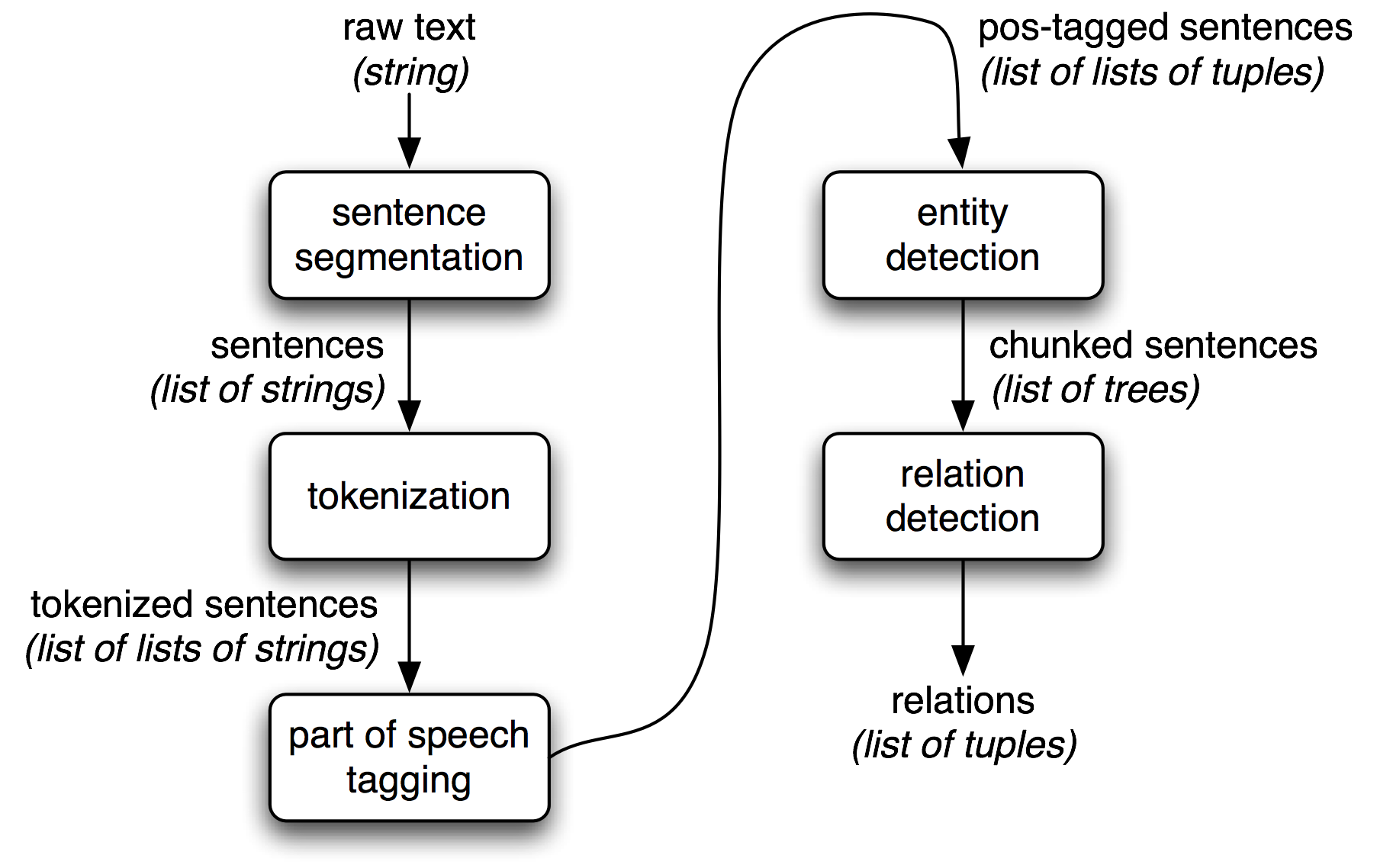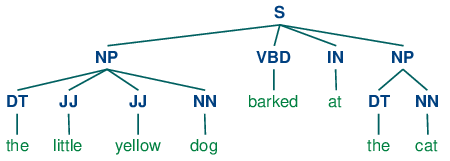1 信息抽取
从数据库中抽取信息是容易的,但对于从自然文本中抽取信息则不那么直观。通常信息抽取的流程如下图:

它开始于分句,分词。接下来进行词性标注,识别其中的命名实体,最后使用关系识别搜索相近实体间的可能的关系。
2 分块
分块是实体识别(NER)使用的基本技术,词性标注是分块所需的最主要信息。本节以名词短语(NP)为例,展示如何分块。类似的还可以对动词短语,介词短语等进行分块。下图展示了NP分块的概念。

分块可以简单的基于经验,使用正则表达式来匹配,也可以使用基于统计的分类算法来实现。主节先介绍NLTK提供的正则分块器。
2.1 基于正则的匹配
NLTK提供了一个基于词性的正则解析器RegexpParser,可以通过正则表达式匹配特定标记的词块。每条正则表达式由一系列词性标签组成,标签以尖括号为单位用来匹配一个词性对应的词。例如<NN>用于匹配句子中出现的名词,由于名词还有细分的如NNP,NNS等,可以用<NN.*>来表示所有名词的匹配。下面的代码演示了匹配上图中冠词-形容词-名词构成的短语块。
import nltk
sent = sentence = [("the", "DT"), ("little", "JJ"), ("yellow", "JJ"),("dog", "NN"), ("barked", "VBD"), ("at", "IN"), ("the", "DT"), ("cat", "NN")]
grammer = 'NP:{<DT>*<JJ>*<NN>+}'
cp = nltk.RegexpParser(grammer)
tree = cp.parse(sent)
print tree
tree.draw()
2.2 处理递归
为了支持语言结构的递归,匹配规则是支持引用自身的,如下面的代码,先定义了NP的规则,而在VP和CLAUSE的定义中,互相进行了引用。
import nltk
grammar = r"""
NP: {<DT|JJ|NN.*>+}
PP: {<IN><NP>}
VP: {<VB.*><NP|PP|CLAUSE>+$}
CLAUSE: {<NP><VP>}
"""
cp = nltk.RegexpParser(grammar,loop=2)
sentence = [("Mary", "NN"), ("saw", "VBD"), ("the", "DT"), ("cat", "NN"),("sit", "VB"), ("on", "IN"), ("the", "DT"), ("mat", "NN")]
cp.parse(sentence)
3 基于分类的分块器
本节将使用nltk.corpus的conll2000语料来训练一个分块器。conll语料使用IOB格式对分块进行了标注,IOB是Inside,Outside,Begin的缩写,用来描述一个词与块的关系,下图是一个示例。

语料库中有两个文件:train.txt,test.txt。另外语料库提供了NP,VP和PP的块标注类型。下表对此语料类的方法进行解释:
| 方法 | 作用 |
|---|---|
| tagged_sents(fileid) | 返回词性标注的句子列表,列表元素(word,pos_tag) |
| chunked_sents(fileid,chunk_types) | 返回IOB标记的语树tree,树的节点元素(word,pos_tag,iob_tag) |
下表对nltk.chunk包提供工具方法进行介绍:
| 方法 | 作用 |
|---|---|
| tree2conlltags(tree) | 将conll IOB树转化为三元列表 |
| conlltags2tree(sents) | 上面方法的逆,将三元组列表转为树 |
下面的代码使用最大熵分类器训练一个iob标记分类器,然后利用标记进行分块。分类器的训练数据格式为((word,pos_tag),iob_tag),经过学习,分类器就可以对新见到的(word,pos_tag)对进行iob分类,从而打上合适的标签。
import nltk
from nltk.corpus import conll2000
# define feature base on pos and prevpos
def npchunk_features(sentence, i, history):
word, pos = sentence[i]
if i == 0:
prevword, prevpos = "<START>", "<START>"
else:
prevword, prevpos = sentence[i-1]
return {"pos": pos, "prevpos": prevpos}
# A tagger based on classifier uses pos info
class ContextNPChunkTagger(nltk.TaggerI):
def __init__(self, train_sents):
train_set = []
for tagged_sent in train_sents:
untagged_sent = nltk.tag.untag(tagged_sent)
history = []
for i, (word, tag) in enumerate(tagged_sent):
featureset = npchunk_features(untagged_sent, i, history)
train_set.append((featureset, tag))
history.append(tag)
self.classifier = nltk.MaxentClassifier.train(train_set)
def tag(self, sentence):
history = []
for i, word in enumerate(sentence):
featureset = npchunk_features(sentence, i, history)
tag = self.classifier.classify(featureset)
history.append(tag)
return zip(sentence, history)
#wrap tagger to tag sentence
class ContextNPChunker(nltk.ChunkParserI):
def __init__(self, train_sents):
tagged_sents = [[((w, t), c) for (w, t, c) in nltk.chunk.tree2conlltags(sent)]
for sent in train_sents]
self.tagger = ContextNPChunkTagger(tagged_sents)
def parse(self, sentence):
tagged_sents = self.tagger.tag(sentence)
conlltags = [(w, t, c) for ((w, t), c) in tagged_sents]
return nltk.chunk.conlltags2tree(conlltags)
test_sents = conll2000.chunked_sents('test.txt', chunk_types=['NP'])
train_sents = conll2000.chunked_sents('train.txt', chunk_types=['NP'])
chunker = ContextNPChunker(train_sents)
print(chunker.evaluate(test_sents))
''' output
ChunkParse score:
IOB Accuracy: 93.6%%
Precision: 82.0%%
Recall: 87.2%%
F-Measure: 84.6%%
'''4 命名实体识别
命名实体识别系统的目标是识别文字提及的命名实体。可以分解成两个子任务:确定NE的边界和确定其类型。
命名实体识别也是适合基于分类器类型的方法来处理。通常标注语料库会标注下列的命名实体:['LOCATION', 'ORGANIZATION', 'PERSON', 'DURATION','DATE', 'CARDINAL', 'PERCENT', 'MONEY', 'MEASURE', 'FACILITY', 'GPE']
NLTK提供了一个训练好的NER分类器,nltk.chunk.named_entify.py源码展示了基于ace_data训练一个命名实体识注器的方法。浏览源码 :-)
下面代码使用nltk.chunk.ne_chunk()进行NE的识别。
import nltk
tagged = nltk.corpus.brown.tagged_sents()[0]
entity = nltk.chunk.ne_chunk(tagged)
print entity5 关系抽取
一旦文本中的命名实体被识别,就可以提取其间的关系,通常是寻找所有 (e1,relation,e2) 形式的三元组。
在nltk.sem.extract.py中实现对语料库ieer,ace,conll2002文本的关系提取。所以下面的代码可以使用正则表达式r'.*\bpresident\b'来提取某组织主席(PER president ORG)的信息。
import re
import nltk
def open_ie():
PR = re.compile(r'.*\president\b')
for doc in nltk.corpus.ieer.parsed_docs():
for rel in nltk.sem.extract_rels('PER', 'ORG', doc, corpus='ieer', pattern=PR):
return nltk.sem.rtuple(rel)
print open_ie()
'''output
[PER: u'Kiriyenko'] u'became president of the' [ORG: u'NORSI']
[PER: u'Bill Gross'] u', president of' [ORG: u'Idealab']
[PER: u'Abe Kleinfield'] u', a vice president at' [ORG: u'Open Text']
[PER: u'Kaufman'] u', president of the privately held' [ORG: u'TV Books LLC']
[PER: u'Lindsay Doran'] u', president of' [ORG: u'United Artists']
[PER: u'Laura Ziskin'] u', president of' [ORG: u'Fox 2000']
[PER: u'Tom Rothman'] u', president of production at' [ORG: u'20th Century Fox']
[PER: u'John Wren'] u', the president and chief executive at' [ORG: u'Omnicom']
[PER: u'Ken Kaess'] u', president of the' [ORG: u'DDB Needham']
[PER: u'Jack Ablin'] u', president of' [ORG: u'Barnett Capital Advisors Inc.']
[PER: u'Lloyd Kiva New'] u', president emeritus of the' [ORG: u'Institute of American Indian Art']
[PER: u'J. Jackson Walter'] u', who served as president of the' [ORG: u'National Trust for Historic Preservation']
[PER: u'Bill Gamba'] u', senior vice president and manager of bond trading at' [ORG: u'Cowen & Co.']
'''






















 528
528











 被折叠的 条评论
为什么被折叠?
被折叠的 条评论
为什么被折叠?








